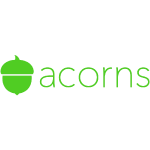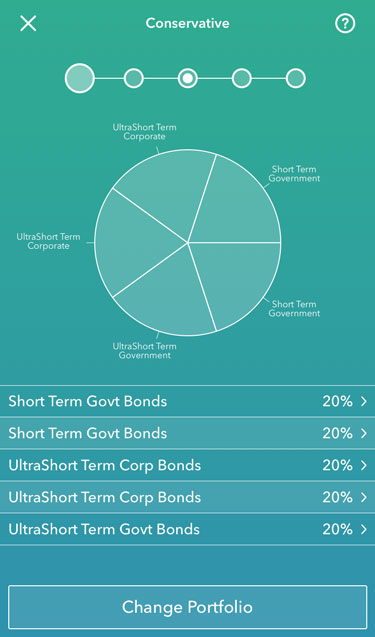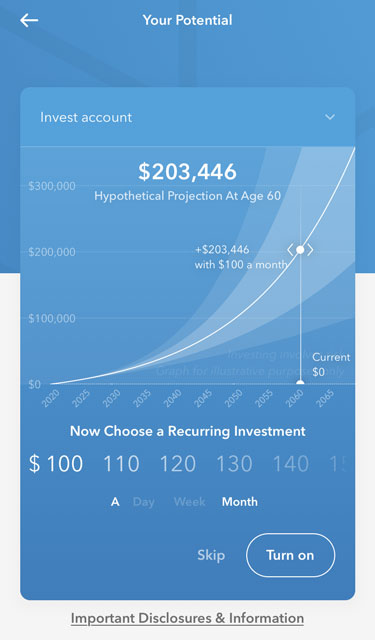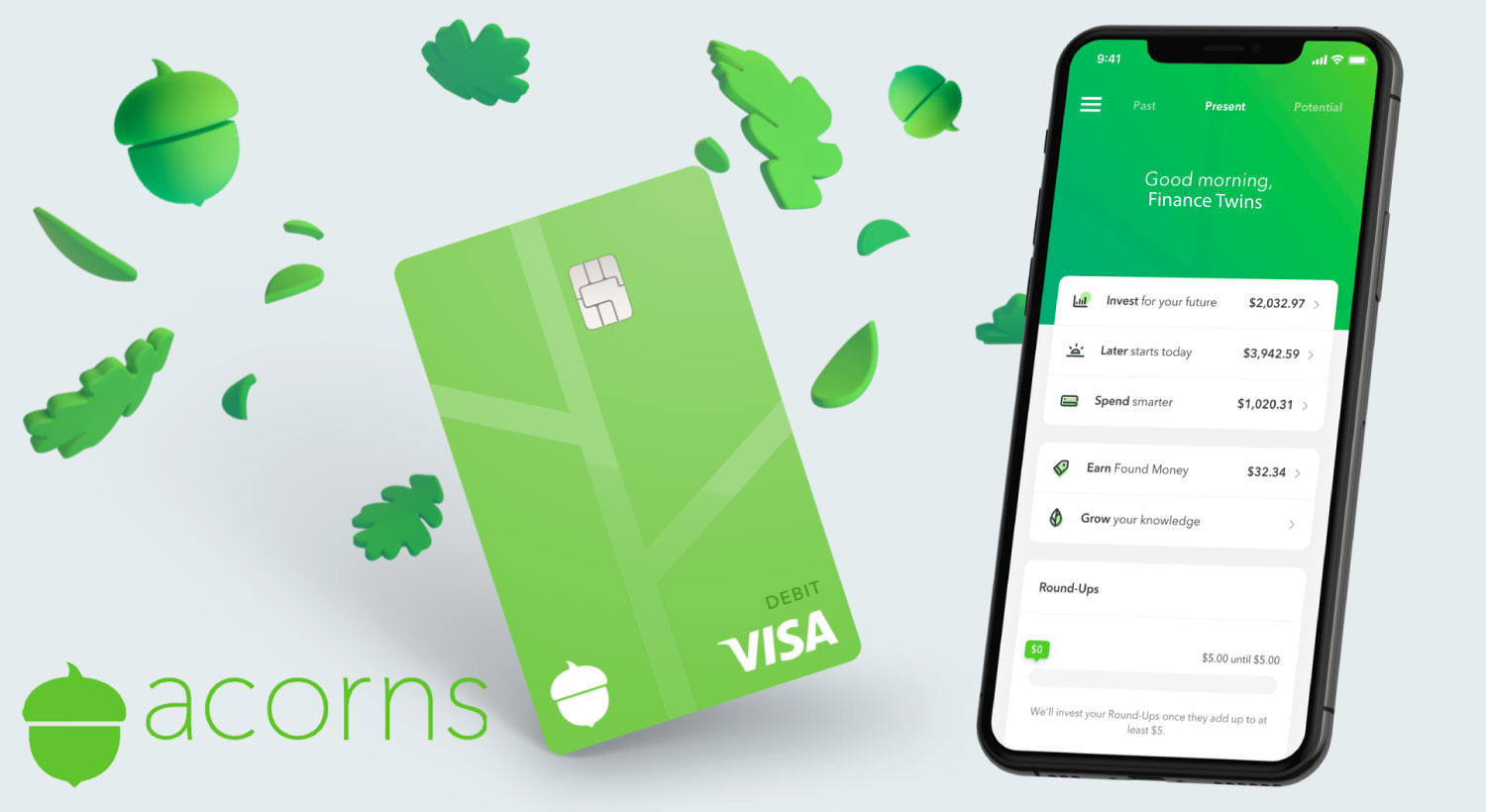Acorns is an investing app that puts your spare change to work. By rounding up everyday purchases and investing the change, Acorns provides a simple and easy introduction on how to invest. This Acorns review will answer all of your questions.
If that sounds too simple and you’d rather have a more hands-on and extensive investing experience, check out Robinhood or Webull. Otherwise, if you’re new to investing and want to learn more, stick around.
With Acorns, the entire process is automated, meaning you won’t have to worry about saving or constantly tracking your investments. This makes Acorns an attractive product for anyone who struggles to save money or simply wants to be less involved in their investments.
Acorns Review

Name: Acorns
Description: is an investing app that puts your spare change to work. By rounding up everyday purchases and investing the change, Acorns provides a simple and easy introduction on how to invest.
Overall
-
Pricing
-
User Experience
-
Ease Of Use
-
Customer Service
Summary
Acorns is an investing app that puts your spare change to work. By rounding up everyday purchases and investing the change, Acorns provides a simple and easy introduction on how to invest.
Pros
- Automatic investments make saving and investing easy and help build good financial habits
- Cashback program via Found Money
- Free access to educational articles and short tutorials
- No minimum deposit to open an account
- Pre-built portfolios ease some of the hassles for new investors
Cons
- $1 – $3 monthly fees mean there are cheaper options for someone investing < $5,000
- The pre-built portfolios are good but not great
- $5 minimum to start investing
- Not a ton of flexibility for someone who wants a more hands-on investing approach
How Does The Acorns App Work?
For a small $1 – $3 monthly fee, Acorns will round up any purchase you make using a linked credit or debit card. They then invest this difference in a pre-built portfolio (a collection of stocks and other investments) to grow it over time.
With their nearest $1 round-up system, Acorns adds to your portfolio in baby steps. This makes it easier to get into the habit of saving a little extra money throughout your day-to-day life.
Let’s say you buy a cup of coffee for $4.25. Acorns will then take that purchase and round up to $5, investing the other $0.75 as it does so. As you continue to invest your spare change, the savings will continue to grow.
You can also choose to deposit funds directly into your Acorns account without making a purchase. You’ll need to deposit at least $5, either as a one-time event or as a daily/weekly/monthly one.
Once you have a minimum account balance of $5 with Acorns, you’re free to start investing. Simply choose one of their pre-built portfolios, which are grouped by how aggressively you want to invest and how much risk you’re willing to take on.
There’s a trade-off between risk and reward, which means it’s often best to have a diversified portfolio to strike a good balance between profits and potential dangers. Luckily, all of Acorns’ portfolios do a good job of doing this for you.
How To Create An Acorns Account
Creating an Acorns account takes only a couple of minutes and takes place entirely within the app itself. You fill out your name and email address, pick a username and password, enter some basic contact information, verify your identity by filling out some more standard information including your social security number and citizenship status, and then select how you want to fund your account.
After that, you’re ready to go. The whole process took me 2 minutes!
Acorns will also assign you a risk tolerance after you fill out a brief questionnaire about your investment goals, level of financial education, and when you’ll need access to the money. This is used to suggest the pre-built portfolio that best matches your desired amount of risk and financial goals.

Acorns’ recommendation will more than likely be a fine fit for your needs. But, it may still be a good idea for you to think about your risk tolerance and consider adjusting their suggestion.
This is less complicated than it sounds. To figure out how aggressively you should invest, Vanguard has a useful risk tolerance questionnaire. This will provide you with a general overview of how your portfolio should look.
You can then pick the pre-built portfolio from Acorns that most closely matches Vanguard’s recommendation.
So, now that you’ve chosen a portfolio (or stuck with the recommended one from Acorns), congratulations! You’re done. All you have to do now is sit back and watch your investments (hopefully) grow over time.
Acorns Pros & Cons
Pros
- Automatic investments make saving and investing easy and help build good financial habits
- Cashback program via Found Money
- Free access to educational articles and short tutorials
- No minimum deposit to open an account
- Pre-built portfolios ease some of the hassles for new investors
Cons
- $5 minimum to start investing
- The pre-built portfolios are good but not great
- $1 – $3 monthly fees mean there are cheaper options for someone investing < $5,000
- Not a ton of flexibility for someone who wants a more hands-on investing approach
Acorns Key Features
What separates Acorns from other financial apps? How should you compare Robinhood vs Acorns or other competitors?
In addition to the automatic saving and investing, Acorns provides a small handful of useful features. Let’s go over the different things you can invest in, where you can put your money, and how you can earn cashback using Acorns.

Available Investment Options
Like we talked about earlier, you can choose from any of Acorns’ five pre-built portfolios. All of them invest in ETFs, which are basically large collections of different stocks or bonds. This means you’ll have a diversified portfolio regardless of which option you choose.
If you’re interested in learning more, there’s a simple way to set yourself up for success with investing: The 3 Fund Portfolio.
Acorns’ portfolios are broken down into five levels of risk and reward. The difference between each of these portfolios comes down to their asset allocation. The biggest shift as you get towards more aggressive portfolios is the ratio of stocks to bonds.
Here’s a breakdown of the exact percentages of stocks and bonds for each pre-built portfolio:
- Conservative = 100% bonds / 0% stocks
- Moderately Conservative = 60% bonds / 40% stocks
- Moderate = 40% bonds / 60% stocks
- Moderately Aggressive = 20% bonds / 80% stocks
- Aggressive = 0% bonds / 100% stocks
In general, most people think of stocks as being riskier and bonds as less risky. A portfolio that is 100% stocks is considered extremely risky since stocks have higher volatility, while the opposite is true for a 100% bond portfolio.
On the flip side, a portfolio with a greater amount invested in stocks has the potential to make more money than one with more bonds.
Acorns’ portfolios mirror this idea, as the conservative ones carry a greater amount of bonds (less risk, lower reward), and the aggressive portfolios contain more stocks (more risk, higher reward).
Cashback With Found Money
Acorns offers cashback through a feature called Found Money. By partnering with 350+ other companies, Acorns allows you to get extra money into your account whenever you make a purchase at a partnering store. This is essentially cashback, as you’ll be able to invest that money or withdraw it into your bank account.
The specific amount given varies between stores, but generally, it’s between 1% and 5%. Currently, Acorns has partnered with big-name companies, including Nike, Lyft, and Sephora, with stated plans for more partners soon.

Available Account Types
You can keep your investments in a personal savings account, an IRA, or an online checking account. Acorns offers both Traditional and Roth IRAs, which are useful if you want to save for the long-term. By using an IRA, you can grow your money faster and with fewer losses to taxation.
But, there’s a catch. We’ll talk about this more in a moment.
Acorns Additional Features
Acorns offers some free educational articles within the app’s “Grow your knowledge” section. Many of these articles are very introductory, so if you’re brand-new to investing and want to know more, this can be a great resource.
The articles discuss everything from what is investing to what are dividends to how long you should invest your money. They’re well worth the read if you want to learn a little bit more about investing.
Acorns also takes care of something known as portfolio rebalancing. While we have a more in-depth guide on portfolio rebalancing, the broad overview is that it keeps your portfolio at the same level of risk as you originally intended.
This helps further automate the investing process and removes one more difficulty the new investor may not want to or feel comfortable managing.
The last feature to discuss is Acorns’ “Your Potential” chart. I love this chart because it helps keep people motivated and on-track towards their financial goals.

This simple graphic shows the power of investing. By putting away as little as $100/month, you could have over $200,000 by the time you’re age 60! That’s the power of compound interest!
How Does Acorns Make Its Money?
Here at TFT, we think it’s important for you to understand how companies, especially those that claim to offer free services, earn their money. Acorns earns its revenue in two main ways: subscription costs and transfer fees.
Acorns’ Subscription Costs
A standard Lite account costs $1 / month and lets you use the round-up and Found Money features in a personal savings account. The more expensive Personal account costs $3 / month and lets you store your funds in an IRA or checking account.
The checking account also comes with a debit card.
While $1 – $3 in monthly fees doesn’t sound like a lot, it’s still a lot higher than many other services like Betterment or M1 Finance. This is because most other services charge as a percentage of your account’s total value rather than a flat rate.
Let’s use Betterment as an example to show how Acorns’ costs are, in reality, much higher for people with less money in their account. Betterment charges 0.25% annually, while Acorns costs either $12 or $36 each year, depending on the service.
If your account has $1,000, Acorns will end up costing 1.2% or 3.6% of the total account value, compared to Betterment’s 0.25%. Put into dollars, this is the difference between paying $2.50 a year vs. $12 or $36. And this difference only worsens as you use smaller amounts.
That said, if your account has at least $5,000, $12 a year in charges works out to 0.24% of the total account value. So, if you’re using thousands of dollars, it may be cheaper to use Acorns (assuming you don’t care about some of the other services offered by different brokerages).
Transfer Fees
The one fee to watch out for with Acorns is the cost of moving your investments to another broker. You’ll pay $50 per ETF, and you may also have more than one ETF to move.
You can avoid this if you first sell-off (liquidate) your investments and then transfer the money to your checking account. But before you run and start selling all of your current investments, speak to a tax professional to understand the tax consequences of doing so.
Is Acorns Safe?
The short answer is, yes. Any account you open with Acorns has SIPC insurance, which covers up to $500,000 in investments or $250,000 in cash.
While a security breach is always possible with any company, Acorns encrypts your personal data and does not store it locally or sell it to other third parties. This means connecting Acorns to your account involves minimal risk.

Should You Use Acorns?
Acorns works great as a very basic introduction to saving and investing. As a tool to help you build healthy financial habits and learn to save regularly, Acorns is a good way to go.
Between its round-up feature and the availability of educational articles on the app, you can cheaply and easily learn the basics of how to invest.
But ultimately, if you’re going to invest with enough money to make Acorns’ fees worthwhile, you could find other brokerages that provide more services for a similar cost.
Even though Acorns offers a good service on its own, the abundance of competitive alternatives means there are cheaper ways to invest over the long term.
However, the behavioral and human psychology aspect cannot be ignored. The fact is that Acorns has helped tons of people save and invest for the first time, and there’s a reason why it’s grown so quickly.
If you’re ready to get started, sign up now and create your account. You’ll be glad you did.
Note: Acorns used to allow college students free access to its paid features. As of the time of writing, Acorns no longer offers this promotion.

Lucas is a personal finance expert, an undergraduate student at Harvard University and the founder of the Personal Finance and Consulting Group at Harvard College (an officially recognized student organization). He has spent much of his life working to increase financial literacy in his surrounding communities through independent financial research and curricula design, and he is currently studying economics with a secondary in music.
